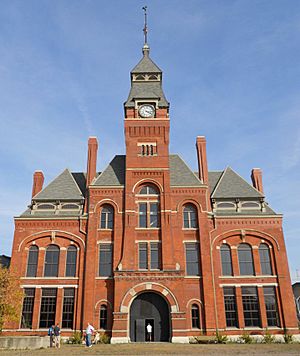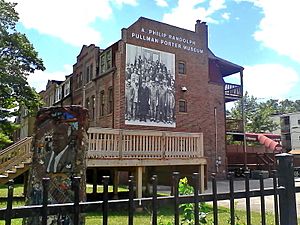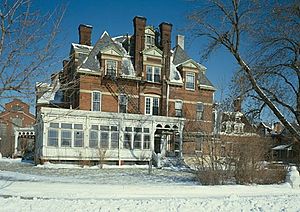Pullman National Monument facts for kids
Quick facts for kids Pullman National Monument |
|
|---|---|

Administration and Factory Complex
|
|
| Location | Chicago |
| Area | 203 acres (82 ha) |
| Built | Construction begun in 1880 |
| Architect | Solon Spencer Beman and Nathan F. Barrett |
| Architectural style(s) | Queen Anne, Gothic Revival |
| Governing body | U.S. National Park Service |
| Website | Pullman National Monument |
| Designated | February 19, 2015 |
| Official name: Pullman Historic District | |
| Designated | October 8, 1969 |
| Reference no. | 69000054 |
| Designated | December 30, 1970 |
| Designated | October 16, 1972 |
| Lua error in Module:Location_map at line 420: attempt to index field 'wikibase' (a nil value). | |
The Pullman National Monument, also known as the Pullman District, is a special place in Chicago. It was the first "planned industrial community" in the United States. This means it was a town built specifically for a factory and its workers.
The district started with the Pullman Company, which made famous sleeping cars for trains. It became one of the most well-known company towns in the U.S. It was also the site of a big workers' strike in 1894, called the Pullman Strike.
The area includes the Pullman factory and the Hotel Florence, named after George Pullman's daughter. You can also find the A. Philip Randolph Pullman Porter Museum here. This museum honors A. Philip Randolph, a leader in labor and civil rights. It teaches about the history of African Americans in the workforce.
Parts of the site are now managed by the U.S. National Park Service. Other parts are still owned by the state of Illinois as the Pullman State Historic Site. The entire Pullman District is a Chicago Landmark and is listed on the National Register of Historic Places. In 2015, it became a National Monument, joining the National Park System.
Contents
How the Pullman Town Began
George Pullman was born in Brocton, New York. He studied engineering and became very successful. In the 1850s, Chicago had problems with dirty water. Pullman invented a way to raise buildings so water could drain better. This made him rich.
With his money, Pullman started the Pullman Palace Car Company in 1867. He wanted to build luxury sleeping cars for trains. His cars were very comfortable and often rented to railroads. Many of his employees were African Americans who had recently been freed from slavery.
Why Build a Company Town?
Pullman cared about his employees' well-being. Chicago was a place where workers often went on strike in the 1870s. When Pullman needed a new factory, he saw a chance to build a town for his workers. This would help his business and his employees.
He bought 4,000 acres (about 1,600 hectares) south of Chicago. This land was near a railroad line and Lake Calumet. He set up a company to manage the land.
Designing the Town
Solon Spencer Beman designed the buildings for the new company town. This included 1,300 homes for workers. Nathaniel Franklin Barrett planned the town's layout and green spaces. Benzette Williams designed the water and drainage systems.
Building started in 1880. The first factory buildings were almost done by fall. The homes were mostly red brick rowhouses with indoor plumbing. These homes were much better than the small, crowded apartments workers usually lived in. The buildings mostly looked like Queen Anne style homes.
Pullman hoped other companies would move to his town. But only his own businesses and suppliers did. More homes were built for less skilled workers. Pullman's employees were mostly young and skilled. The company charged rent to make a 6% profit. By 1883, about 8,000 people lived in the community. People from many countries lived there, but African Americans were not allowed to live in the town itself. Women worked for the Pullman Company, mostly sewing.
The Pullman Strike of 1894
The city of Chicago took over Pullman in 1889. But the company still controlled how the town was run. The town didn't make as much money as George Pullman hoped.
In 1893, the World's Columbian Exposition was held in Chicago. Pullman was a popular place for visitors to see. But that same year, a big economic downturn called the Panic of 1893 hit. This hurt the railroad business.
Demand for sleeping cars dropped. To keep his company profitable, Pullman cut workers' wages. But he did not lower the rent, which was taken directly from paychecks.
Workers Take Action
The American Railway Union (ARU) was formed in Chicago in 1893, led by Eugene V. Debs. Many white Pullman workers joined this union. Pullman employees asked for higher wages, but their requests were ignored.
On May 11, 1894, the workers went on strike. Pullman's company had enough money to last through a short strike. So, the ARU started a boycott. They refused to run any trains that had Pullman cars.
This boycott spread across the country and stopped many trains. Railroad companies fought back. They used new workers to replace the strikers. They also made sure Pullman cars were attached to mail cars. If strikers stopped trains with mail, the government would have to get involved.
Government Steps In
Trains carrying mail were indeed stopped. The government said the boycott broke the Sherman Antitrust Act, a law about fair business. Thousands of U.S. Marshals and Army troops were sent to Chicago. They were there to end the boycott.
Fights broke out between workers and the military. Many people were hurt or killed. After ARU leaders, including Debs, were put in jail, the strike ended. Some workers who promised to leave the union were allowed to return to their jobs.
Even though many people didn't support the boycott, the strike damaged the Pullman brand. George Pullman died in 1897. His grave was sealed in concrete and steel to protect it.
What Happened Next?
The Pullman Strike changed how labor unions worked in America. It showed how powerful a union could be. But it also showed that the government could step in to stop strikes. The Supreme Court later agreed with the government's actions.
In 1898, the Illinois Supreme Court made the Pullman Company sell its non-factory properties. Residents were given the first chance to buy their homes. Most of the land was sold by 1907.
Under its second president, Robert Todd Lincoln, the Pullman Company started making all-steel cars. This cost $5 million to update the factories. The company remained a top train car maker. However, the town of Pullman never felt like a company town again. Workers moved to other neighborhoods nearby.
African American Workers and Unions
In 1925, African Americans working for Pullman started to form a union. It was called the Brotherhood of Sleeping Car Porters, founded by A. Philip Randolph in New York City. About 44% of Pullman's workers were porters, making Pullman the largest employer of African Americans in the country.
In 1937, the union and the company reached an important agreement. This was the first major labor deal between a company and an African American union. The NAACP praised the agreement. They saw it as a big step forward for African Americans to gain respect and better pay.
The End of the Pullman Company
Over time, fewer people traveled by train. More people started using cars and airplanes. This led to the decline of the Pullman Company. After a big reduction in size in the 1940s, the company mostly closed by 1957. It officially stopped working in 1969. Parts of the factory were later used by steel companies.
Important Buildings and Landmarks
The Factory and Administration Complex
The main factory buildings in Pullman were very fancy for industrial buildings. They were designed to look like they were in a park. They overlooked an artificial lake called Lake Vista. This lake helped cool the factory's steam engine.
The buildings were long and had good light and air. The main front of the factory faced the Illinois Central train tracks. This meant it was one of the first things visitors saw. The buildings were designed for a smooth manufacturing process, like an early assembly line.
In the movie The Polar Express (2004), the buildings at the North Pole were inspired by the Pullman Factory.
Hotel Florence: A Grand Welcome
The Hotel Florence opened on November 1, 1881. It was named after George Pullman's daughter. The hotel was meant to show off the town to visitors. It had fifty rooms and was the only place in the community with a bar.
It cost $130,000 to build. A new section was added in 1914, making it 23,000 square feet (about 2,137 square meters). George Pullman had a special suite on the second floor for his visits. The rooms on each floor offered different levels of luxury. The second floor had the fanciest rooms. The hotel has recently been restored, especially its first floor and basement.
Saving and Restoring Pullman
In 1960, there was a plan to tear down the community to build a new industrial park. Residents formed the Pullman Civic Organization (PCO) to save it.
On October 8, 1969, the remaining 300 acres (about 120 hectares) of the neighborhood were added to the National Register of Historic Places. The next year, it became a National Historic Landmark District. This means it was seen as having "exceptional value to the nation."
The PCO gave money to help residents fix up their houses. A non-profit group, the Historic Pullman Foundation, bought several important buildings to restore them in the 1970s.
The State of Illinois bought Hotel Florence and the Administration and Factory Complex in 1991. They made it a state historic site. However, a fire in 1998 badly damaged the factory building before it could open to visitors. It is now being rebuilt.
On February 19, 2015, President Barack Obama made Pullman a National Monument. This made it part of the National Park Service. It was the first National Park Service site in Chicago. In 2017, the National Park Service approved a plan to restore the clock tower building and make it a visitor center. They also plan to rebuild the main entrance between the factory and the homes. First, they need to remove toxic soil from the site, which was polluted when the factory was running.
Learning About Pullman
The Pullman National Monument works with a non-profit group called the American Passenger Rail Heritage Foundation. They offer educational programs for train passengers on the South Shore Line. On some Saturdays, special guides ride the train. They tell passengers about the park and other interesting places they see outside the window.
Images for kids




